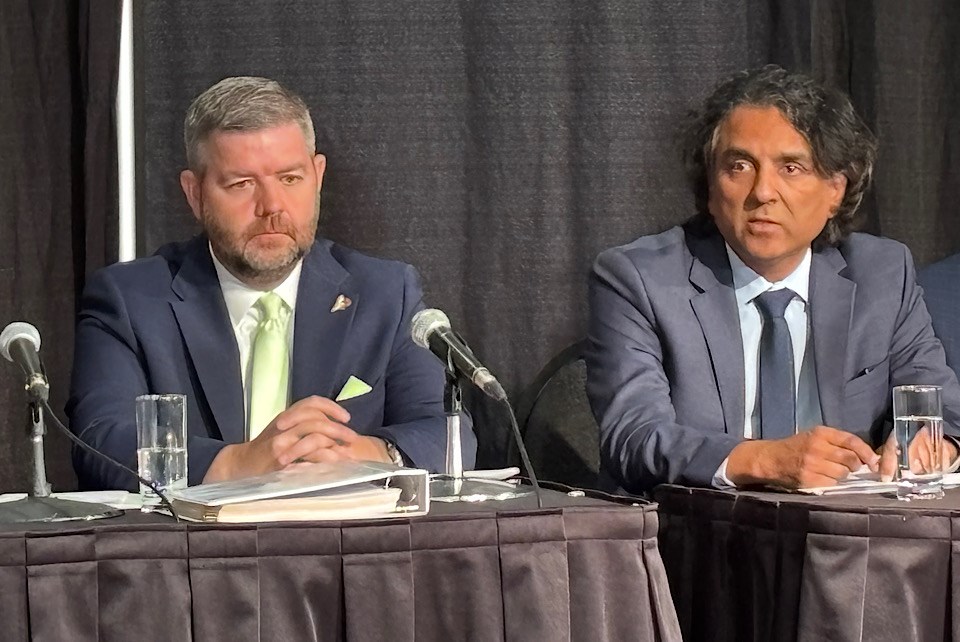SASKATOON — SaskPower is facing considerable pressures in the coming years that will likely see your power bills going up.
Rupen Pandya, President and Chief Executive Officer of SaskPower, admitted those increases are likely to happen as he pointed to the need for significant infrastructure investments down the road.
Pandya said that in “terms of relife cycles on some of our generating assets, there will be rate increases required certainly going forward, and we hope to keep those as modest as possible.”
Pandya was speaking to reporters at the announcement of the release of the Crowns’ annual report in Saskatoon. SaskPower reported a $76 million net income, which was below their budgeted forecast.
But rate increases are not coming immediately. Pandya said there is a process that would need to be followed should it happen.
“So rate increases are always part of our planning cycle. Typically, what we will do is provide those through the rate review panel. At present, our colleagues in Crown Investment Corporation are looking at a rate strategy for all the Crown corporations. Once they have provided us with direction on that, typically the process is we go to the rate review panel. Until such time as the rate review panel makes a decision, that's when we would communicate what those rate increases look like.”
Infrastructure needs putting pressure on rates
The main driver of potential increases is a need for infrastructure for the provincial Crown. Minister for SaskPower Jeremy Harrison spoke about some of the pressures they were facing and some decisions that will need to be made.
“We're going to be making significant investments into infrastructure, transmission infrastructure at SaskPower,” said Harrison. “That is based on really (the) kind of energy security decisions that we are considering right now.”
Harrison noted that the north and south grids in Saskatchewan are not linked. Harrison said right now they have to move power through interties with Manitoba to get it up North.
That is not seen as ideal. Harrison pointed to major challenges seen during the wildfires in going that route, with power supply being cut off.
But if they were to connect the north and south grid, Harrison said it would be an expensive proposition.
“We were talking nearly a billion dollars to connect our northern and southern grids here in the province. But that's something we're going to be taking a very, very hard look at. And it is a nearly billion dollar project.
“So those sort of decisions are going to mean that there are pressure on rates in SaskPower. We saw in Manitoba there was an 11 per cent increase on their utility rates through Manitoba Hydro… So we're going to be taking a look at that. None of these decisions have been made with finality.”
Harrison also fired a shot at the NDP, saying that their contention that the coal fire plants should be shut down would drive up rates even more.
“So that would mean four new Aspen plants. That would be, under current cost scenarios, nearly $10 billion. And that would be to meet the federal Clean Electricity Regulations, which their position is the government needs to meet. That would be $10 billion starting this year, which would mean that even starting last year, we would have had to double the SaskPower rates.”
“So we're not going to be doing that. We're going to be doing the responsible decision for the people of this province. But are there pressures on rates? There absolutely are. But we're not doubling them, which is what the NDP plan would lead to.”
Other pressures facing SaskPower
There are more pressures facing SaskPower as well. Pandya pointed to a massive increase coming to the power load in the coming decades.
“So the current grid in Saskatchewan is about 5,900 megawatts, and we are forecasting an almost doubling of load between now and 2050,” said Pandya.
“So if you say 11,000 megawatt grid, that's a significant challenge for us as an organization. Between 2025 and 2050, to deploy another 5,000 or 6,000 megawatts of power will be an unprecedented challenge.”
Pandya said it was not just SaskPower — it's “every utility in North America is facing the same doubling of load scenario. So, you know, this is the entire industry faces that challenge, and yes, we're doing the planning to ensure we can do that in the most responsible and reliable way.”
Minister Harrison echoed that sentiment. “We are going to be seeing tremendous increase in power demand, whether it be here in Saskatchewan (and) I think every jurisdiction is facing this as well."
As for the recent announcement to keep coal power plants going, Harrison said what they decided was to “look at this through the lens of energy security, reliability, and affordability.
“Those were the lenses that we were looking at. How can we supply and make sure that when it's minus 40 and it's Jan. 20 and people turn on the lights, they're going to work. That really is, at the end of the day, what this comes down to.”
Harrison said they would be taking “an all-of-the-above approach to power generation.” He also said this was not ideological.
“If we had hydro, we'd be doing more hydro. If we had gas, we'd be doing more gas What we have here in this province is coal, and we have a multi-hundred-year supply of coal in this province. And we have a long history of utilizing that resource for generating power in this province as well. So, we are going to be continuing with the life extension of the facilities that we have in operation right now, Boundary Dam, Poplar River, and Shand.”




